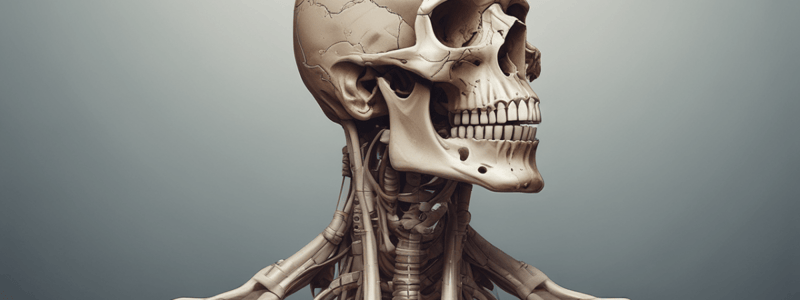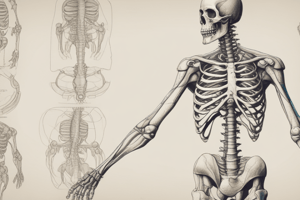Podcast
Questions and Answers
What is the function of the articular cartilage?
What is the function of the articular cartilage?
- Provides a smooth gliding surface for tendons and ligaments to move (correct)
- Houses osteocytes in small spaces
- Contains yellow marrow in adults
- Secretes organic matrix of bone
Which cells are responsible for forming bone by secreting its organic matrix?
Which cells are responsible for forming bone by secreting its organic matrix?
- Osteoblasts (correct)
- Osteogenic cells
- Chondrocytes
- Osteocytes
What is contained in the medullary cavity of adult bones?
What is contained in the medullary cavity of adult bones?
- Red marrow
- Epiphyseal plate
- Periosteum
- Yellow marrow (correct)
Which vitamin is essential for collagen synthesis?
Which vitamin is essential for collagen synthesis?
Which hormone increases blood calcium levels by increasing bone resorption?
Which hormone increases blood calcium levels by increasing bone resorption?
Where are the osteocytes found in bone tissue?
Where are the osteocytes found in bone tissue?
What connects the Haversian canals and allows blood vessels and nerves to pass through the bone?
What connects the Haversian canals and allows blood vessels and nerves to pass through the bone?
Which structure is a tough connective tissue sheath surrounding the bone?
Which structure is a tough connective tissue sheath surrounding the bone?
What stimulates the thyroid gland parafollicular cells to release more calcitonin?
What stimulates the thyroid gland parafollicular cells to release more calcitonin?
What is the function of parathyroid hormone (PTH)?
What is the function of parathyroid hormone (PTH)?
What is the role of calcitriol in calcium homeostasis?
What is the role of calcitriol in calcium homeostasis?
Which division of the skeletal system is composed of 126 bones?
Which division of the skeletal system is composed of 126 bones?
What type of bone is characterized by being mostly compact bone tissue in their diaphyses?
What type of bone is characterized by being mostly compact bone tissue in their diaphyses?
Which bones are generally thin and composed of two parallel plates of compact bone?
Which bones are generally thin and composed of two parallel plates of compact bone?
What branch of medical science is concerned with the prevention or correction of disorders of the musculoskeletal system?
What branch of medical science is concerned with the prevention or correction of disorders of the musculoskeletal system?
Which of the following is a characteristic of sesamoid bones?
Which of the following is a characteristic of sesamoid bones?
Flashcards are hidden until you start studying
Study Notes
Structure of Bone
- Articular cartilage provides a smooth gliding surface for tendons and ligaments to move.
- Epiphyseal line is a remnant of the epiphyseal plate where the bone grows in length.
- Epiphysis is the rounded end of the long bone, formed by a secondary ossification center.
- Diaphysis is the shaft of the long bone.
- Medullary cavity contains yellow marrow in adults and red marrow in infants.
- Periosteum is a tough connective tissue sheath that surrounds the bone and anchors tendons and ligaments.
- Compact bone is made up of tightly packed osteons (cylindrical structures containing Haversian canals).
- Cancellous (spongy) bone is made up of a network of thin, plate-like trabeculae that form a honeycomb-like structure.
Histology of Bone (Osseous Tissue)
- Osteocytes are mature bone cells that maintain the bone matrix.
- Osteoblasts are bone-forming cells that secrete the organic matrix of bone.
- Osteogenic cells are stem cells that develop into osteoblasts.
- Lacunae are small spaces in the bone matrix that house the osteocytes.
- Canalliculi are tiny channels that connect the lacunae and allow nutrients and waste products to pass through.
- Haversian canals are central canals in the osteons that contain blood vessels and nerves.
- Volkmann's canals are channels that connect the Haversian canals and allow blood vessels and nerves to pass through the bone.
Factors Affecting Bone Growth
- Minerals: calcium and phosphorus are needed for bone growth.
- Vitamins:
- Vitamin A stimulates osteoblast activity.
- Vitamin C is required for collagen synthesis.
- Vitamin D is required for calcium absorption from foods.
- Vitamin K and B12 are needed for bone protein synthesis.
- Hormones:
- Growth hormone (GH) is produced by the pituitary gland.
- Insulin-like growth factors are produced by the liver and bone.
- Sex hormones: estrogen and testosterone.
Calcium Homeostasis
- Parathyroid hormone (PTH) is secreted by parathyroid glands and increases blood calcium levels by:
- Increasing bone resorption (release of calcium from bone into the blood).
- Decreasing calcium excretion by the kidneys.
- Calcitonin (CT) is secreted by parafollicular cells of the thyroid gland and decreases blood calcium levels by:
- Decreasing bone resorption.
- Increasing calcium excretion by the kidneys.
Divisions of the Skeletal System
- The Axial skeleton consists of bones arranged along the longitudinal axis of the body and consists of 80 bones.
- The Appendicular skeleton consists of 126 bones in the upper and lower extremities (limbs) and pectoral (shoulder) and pelvic (hip) girdles.
Types of Bones
- Long bones: mostly compact bone tissue in their diaphyses, but have considerable amounts of spongy bone tissue in their epiphyses.
- Short bones: cube-shaped, consists of spongy bone tissue except at the surface, which has a thin layer of compact bone.
- Flat bones: generally thin, composed of two parallel plates of compact bone tissue enclosing a layer of spongy bone tissue, provide extensive areas for muscle attachment.
- Irregular bones: complex shapes.
- Sesamoid bones: develop in certain tendons, not always completely ossified, protect tendons from excessive wear and tear.
Studying That Suits You
Use AI to generate personalized quizzes and flashcards to suit your learning preferences.




